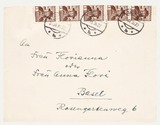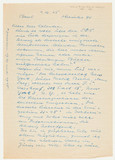Alexander Moritz Frey to Florianna Storrer-Madelung, Salzburg, 30 March 1936
“The dreary road to the land of starvation”This letter by Alexander Moritz Freys vividly documents the financial straits of a writer forced into exile, particularly his disheartening attempts to have his works printed by publishers and in the features section of newspapers. Frey’s “misery letter”, as he called it, was written from exile in Salzburg to Florianna Storrer-Madelung, who from 1930 was the assistant editor of the features section of the National-Zeitung newspaper in Basel.
Alexander Moritz Frey, letter to Ossip Kalenter, 1945
Contemporary studies of exile literatureF. C.
Alexander Moritz Frey’s notebooks
Hell and heaven in exileThe Swiss Literary Archives (SLA) hold a fragmentary estate of Munich-born author Alexander Moritz Frey who fled to Austria in 1933 then moved on to Switzerland following the annexation of Austria in 1938. It consists solely of two boxes of notebooks and notebook transcripts prepared by a third person, all of which await further research.
Emil Ludwig, Resident Alien’s Identification Card, 1944
Ludwig’s years of exile in the USAFrom 1906, Emil Ludwig lived in Moscia, in the Swiss municipality of Ascona. After becoming a Swiss citizen in 1932, he spent the first years of the Nazi dictatorship in Switzerland.
Georg Kaiser, Das Floss der Medusa [„The Raft of the Medusa“], manuscript
A children’s tragedyGeorg Kaisers immense creative power remained in full spate after 1933 and during the seven years of his exile in Switzerland. Between 1938 and 1945, he wrote nine dramas in all; these were premièred at theatres in Basel and Zurich and published by Querido and Oprecht.
Georg Kaiser’s membership card, issued by the Reichsschrifttumskammer (Reich Chamber of Literature)
Member 11160On 5 May 1933, Georg Kaisers was excluded from the Prussian Academy of the Arts. The NSDAP newspaper Völkische Beobachter had previously anathematised the famous Expressionist dramatist, claiming that the play Der Silbersee [The Silver Lake], set to music by Kurt Weill and successfully premièred in Leipzig in February, was “un-German” and “cultural Bolshevist” propaganda.
Jakob Haringer: Das Fenster [The Window], poetry typescripts
The scrap paper poetJakob Haringers poetry makes references to Expressionism, but its ballad-like style and the moods evoked by its musicality place it more in the tradition of François Villon, and particularly of Romanticism. In 1934, while in exile, Haringer published his poem Deutschland-Ode [Ode to Germany] in the exile newspaper Neuen Tage-Buch This work leaves the reader in no doubt of his anti-Fascist sentiments and concludes with an optimistic look ahead to the time when the country would finally be liberated: “The blitz.
Jakob Haringer’s refugee identity document, 22 January 1944
Hide-and-seek with the authoritiesThe refugee identity document of Jakob Haringer, whose German citizenship was revoked in July 1936, bears eloquent witness to the regular, thorough checks by the Aliens Police to which exiles in Switzerland were subjected between 1933 and 1945. Haringer played hide-and-seek with the rigid Aliens Police for several years.
Klaus Mann, letter to Steinberg Verlag, December 1948
Andre Gide and the Crisis of Modern ThoughtAndré Gide was one of Klaus Mann's early literary inspirations, possibly even the lodestar of his literary life, as Mann himself makes clear in his eminently readable autobiography Der Wendepunkt (“The Turning Point”, 1952): “What he had to offer me, what drew me to him, was a kind of moral, intellectual ‘authorisation’: a spiritual legitimation and artistic objectification of my subjective restlessness and uncertainty.” Mann’s lifelong – albeit extremely one-sided – admiration of Gide’s work and character, which in Mann’s view embodied the essence of the good European, was expressed in several essays and culminated in the monograph André Gide and the Crisis of Modern Thought, initially published in English by New York publishing company Creative Age in 1943.
Ossip Kalenter, review of Haringer’s Das Fenster (“The Window”) in Aufbau
Signs of life from Jakob HaringerFrom the 1920s on, Ossip Kalenter mainly made a name for himself as a newspaper and features author, writing countless articles for the Frankfurter Zeitung, the Bernese Bund, the Neue Zürcher Zeitung, Basel’s National-Zeitung and (especially during his exile in Czechoslovakia between 1934 and 1939) the Prager Tagblatt. Hermann Kesten said in one review that Kalenter looked “like a novelist who had dressed up as a features writer”.





![Manuscript: Georg Kaiser, Das Floss der Medusa [„The Raft of the Medusa“] Manuscript: Georg Kaiser, Das Floss der Medusa [„The Raft of the Medusa“]](/KIE/Content/EN/Images/objects/kaiser-georg-das-floss-der-medusa-manuskript-en.jpg?__blob=thumbnail&v=4)

![Manuscript notes: Jakob Haringer, Das Fenster [The Window] Manuscript notes: Jakob Haringer, Das Fenster [The Window]](/KIE/Content/EN/Images/objects/haringer-jakob-das-fenster-gedichttyposkripte-en.jpg?__blob=thumbnail&v=4)



